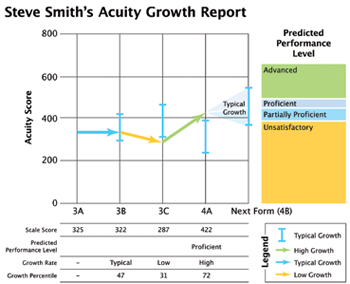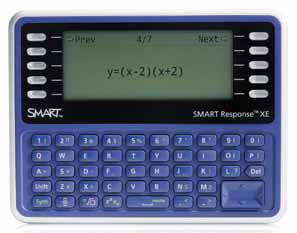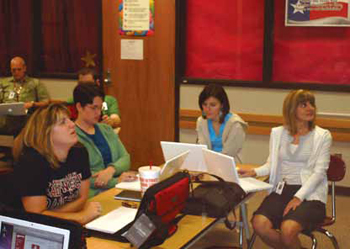What it means, how they do it

How three districts automate assessment for substantive results
Predictive Assessment
What Is It?
Predictive assessment gives teachers a prediction of how students are likely to perform on state summative exams three, six, or nine months before taking them. The purpose is to allow teachers to use the information to understand each child’s strengths and weaknesses to improve results on those summative tests.
The Technology Component
Jefferson County (CO) Schools has used McGraw Hill/CTB’s Acuity since 2006 as part of its instruction, intervention, and assessment initiative. Acuity, which is aligned to state standards, is an integration of predictive and diagnostic assessments, reports, instructional resources, item banks, and item authoring.
Implementation began as a pilot in two articulation areas. The district hired a team to implement Acuity, train teachers and administrators, help interpret the data, and—perhaps most important—assist teachers with developing and using instructional skills and strategies to change results. After one year, the Jeffco Board of Education approved a threeyear implementation plan, starting with the 25 schools that had not shown the highest gains in the previous three years.
Tools and ideas to transform education. Sign up below.
The Acuity predictive assessments in mathematics and reading are administered online in September, November, and April (right after the Colorado Student Assessment Program, CSAP). Teachers receive immediate information about student progress and growth, which allows them to predict student performance on the CSAP. They use this information to concentrate efforts where students need intervention.
According to Vicki Ferrari, assistant director of assessment and research, the November assessment is highly predictive of the CSAPs. “Our teachers feel empowered that they can change the outcome for their students,” she says.
Last year, Jeffco students were predicted to go down in reading at every grade level. When the chief academic officer saw the results, she was able to work with the instruction department to restructure the Principal Institute that was beginning the following week. The district leaders shared the Acuity data with the principals and the curriculum team asked them to do data analysis with their teachers and come up with a plan for their buildings. Each month, the principals shared ideas and progress reports. Ferrari’s team used Acuity’s customized assessments to develop probes for third- through eighth-grade teachers to give to their students before the state assessment. Because of this intensive process, the district maintained its reading scores in all but a few grade levels.
Jeffco students outperform the state in all grade levels and content areas on the CSAPs, including reading and mathematics. Ferrari says using Acuity has improved teachers’ understanding of the relationship between instruction and assessment, and everyone receives the information they need to ensure that the district meets the needs of each student.
“Acuity is a really comprehensive system,” says Ferrari. “Using Acuity helps us to know the instructional needs of our schools and to determine instructional patterns and trends up to the district level.”
With Acuity, tracking student growth is a breeze.Formative Assessment

What Is It
Formative assessment is a process used by teachers and students during instruction that provides feedback to adjust ongoing teaching and learning to improve students’ achievement of intended instructional outcomes.
The Technology Component
One of the most popular ways to do formative assessment is with student response systems (SRS) or “clickers.” Using handheld remotes, a receiver, and assessment software, teachers can give a pop quiz or an already-prepared test. Students use the remotes to respond instantly, and the software tallies and summarizes the results, allowing teachers to adjust their lessons as needed.
Jane Mintz, director of educational technology at Oak Park (CA) Unified School District, is a huge fan of using clickers for formative assessment. “I taught for 20 years. I’d say, ‘Everybody with me?’ They would all nod, but I had no clue what they really understood.”
Now, thanks to the SMART Response XE system, Oak Park teachers can be absolutely certain about what their students comprehend. “The kids never know when an assessment is coming, so they have to stay focused,” says Mintz. “If only 30 percent get the answer correct, I know we need to go to another example of the same concept until everyone gets it. It’s really powerful.”

The SMART Response XE system has a full
keyboard for math and science
assessment. Teachers in Oak Park are using the system in various ways. Some like to ask students to click in last night’s homework answers; they can use the results to break students into small groups and help students who are struggling. Other teachers use the clickers for informal Q&A. Because the devices are anonymous, language arts teachers use them to broach sensitive subjects. “If the main character is going through a moral dilemma, a teacher can ask questions that spark a more honest conversation,” says Mintz.
Overall, Mintz says using this type of technology for formative assessment is a win-win. “Sometimes kids think they’re following along and then realize, ‘No, I don’t get this.’ That no longer happens.”
Summative Assessment
What Is It
Summative assessment, which is cumulative, is used to determine whether students have met course goals or learning outcomes at the end of a course or program.
The Technology Component
Electronic portfolios (e-portfolios)—digitized collections of text-based, graphic, or multimedia elements archived online or on a DVD or CD-ROM—are a type of summative assessment that lets students showcase their skills.
Students at White Oak (TX) Independent School District are creating and customizing e-portfolios for academic, career, and personal uses. To make the process easy to manage, the district decided to use blogs to “house” the e-portfolios. “I wanted it to be open source so students could take their portfolios to another school and use them after graduation,” says Scott S. Floyd, director of instructional technology. “WordPress offers that capability.”
White Oak ISD teachers learn how to create blogs and e-portfolios.To start the effort, teachers learned how to use blogs for classroom Web pages. Once they were comfortable with blogging, they learned about e-portfolios. “Blogs let us privatize, hide, and edit,” says Floyd. “Students can modify their blogs to fit their changing needs or even start a whole new blog and move what they want.”

Third-, fourth-, and fifth-grade students keep their e-portfolios on flash drives that they purchase as part of their school supplies. Their portfolios include writing samples, artwork, and other projects. In sixth grade, they learn about blogging and start their own blogs, fine-tuning them in seventh and eighth grade as they learn more about blogging and showing off their skills to the real world. In high school, they continue to maintain their blogs based on their career goals.
Floyd says the district doesn’t refer to the e-portfolios as an assessment piece that will earn a grade. “If we do, they’ll reject it,” he says. “We want students to feel that their portfolios are a safe place to put themselves out there. By high school, they realize what they are for and that, by graduation, they’ll have a digital piece for college or job opportunities.”
Educator survey shows new skills assessments needed
As educators across the nation increasingly incorporate 21st century skills into instructional strategies, they believe the federal government should support the development of new assessment models that effectively measure those skills, according to school district leaders surveyed previously by the National School Boards Association.
More than 35 percent of respondents who attended the NSTA T+L conference last fall listed “assessing 21st century skills” as the top education technology priority that Congress and the Obama administration should address. More than 43 percent said their district already has created new assessment measures to incorporate such skills as problem-solving, teamwork, and critical thinking.
